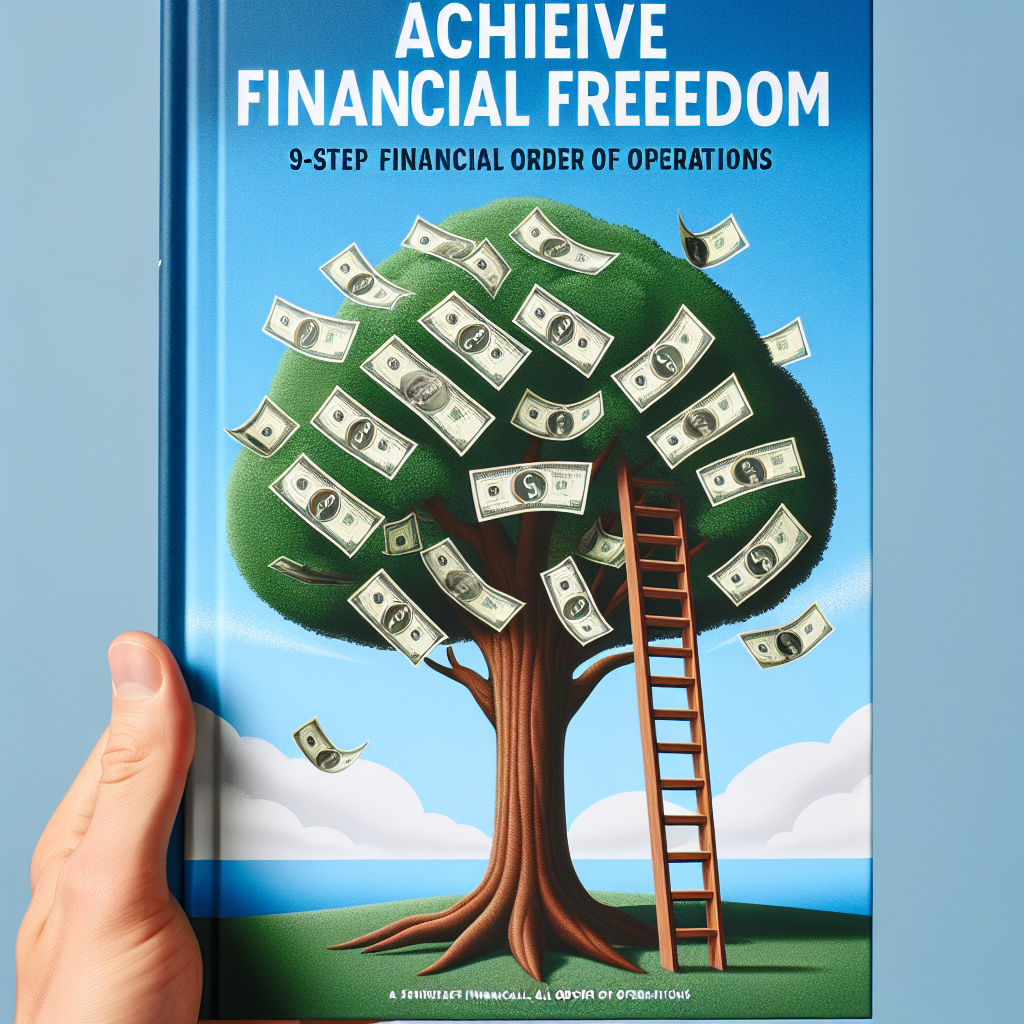-
Table of Contents
- Achieve Financial Freedom: The Money Guy’s 9-Step Financial Order of Operations
- Step 1: Cover Your Deductibles
- Step 2: Establish an Emergency Fund
- Step 3: Get the Employer Match
- Step 4: Pay Off High-Interest Debt
- Step 5: Max Out Roth IRA or HSA
- Step 6: Max Out 401(k)
- Step 7: Save for College
- Step 8: Pay Off Low-Interest Debt
- Step 9: Build Wealth and Give
- Case Studies and Examples
- Case Study 1: Sarah’s Journey to Financial Freedom
- Case Study 2: John and Emily’s Path to Financial Independence
- Conclusion
Achieve Financial Freedom: The Money Guy’s 9-Step Financial Order of Operations

Financial freedom is a goal that many aspire to but few achieve. The journey to financial independence can be complex and daunting, but with the right roadmap, it becomes much more manageable. The Money Guy’s 9-Step Financial Order of Operations provides a structured approach to achieving financial freedom. This article will delve into each step, offering valuable insights, examples, and statistics to guide you on your path to financial independence.
Step 1: Cover Your Deductibles
The first step in the Financial Order of Operations is to ensure you have enough cash to cover your insurance deductibles. This is your initial safety net, protecting you from unexpected expenses that could derail your financial plans.
For example, if you have a health insurance plan with a $1,000 deductible, you should have at least $1,000 set aside in a readily accessible account. This ensures that you can cover any immediate medical expenses without resorting to high-interest debt.
Step 2: Establish an Emergency Fund
Once your deductibles are covered, the next step is to build an emergency fund. This fund should cover 3-6 months of living expenses and is designed to protect you from larger financial shocks, such as job loss or major medical expenses.
According to a 2021 survey by Bankrate, only 39% of Americans could cover a $1,000 emergency with savings. This statistic underscores the importance of having a robust emergency fund. By setting aside 3-6 months of expenses, you create a financial buffer that allows you to navigate life’s uncertainties with greater confidence.
Step 3: Get the Employer Match
Many employers offer a 401(k) match as part of their benefits package. This is essentially free money that can significantly boost your retirement savings. The third step in the Financial Order of Operations is to contribute enough to your 401(k) to get the full employer match.
For instance, if your employer offers a 50% match on contributions up to 6% of your salary, you should contribute at least 6% to take full advantage of this benefit. Failing to do so is akin to leaving money on the table.
Step 4: Pay Off High-Interest Debt
High-interest debt, such as credit card debt, can be a significant barrier to financial freedom. The fourth step is to aggressively pay down any high-interest debt you have. This is crucial because the interest on these debts can quickly accumulate, making it difficult to achieve your financial goals.
Consider this: the average credit card interest rate in the U.S. is around 16%. If you have $10,000 in credit card debt, you’re paying $1,600 annually in interest alone. By prioritizing the repayment of high-interest debt, you free up more money to invest and save for the future.
Step 5: Max Out Roth IRA or HSA
After addressing high-interest debt, the next step is to maximize contributions to tax-advantaged accounts like a Roth IRA or Health Savings Account (HSA). These accounts offer significant tax benefits that can enhance your long-term financial health.
A Roth IRA allows your investments to grow tax-free, and qualified withdrawals are also tax-free. In 2023, the contribution limit for a Roth IRA is $6,500 for individuals under 50 and $7,500 for those 50 and older. An HSA, on the other hand, offers triple tax benefits: contributions are tax-deductible, growth is tax-free, and withdrawals for qualified medical expenses are also tax-free.
Step 6: Max Out 401(k)
Once you’ve maxed out your Roth IRA or HSA, the next step is to maximize contributions to your 401(k). In 2023, the contribution limit for a 401(k) is $22,500 for individuals under 50 and $30,000 for those 50 and older.
Maximizing your 401(k) contributions not only boosts your retirement savings but also reduces your taxable income, providing immediate tax benefits. This step is crucial for building a substantial retirement nest egg.
Step 7: Save for College
If you have children and plan to contribute to their college education, the seventh step is to start saving for college. One of the most effective ways to do this is through a 529 plan, which offers tax advantages for education savings.
According to the College Board, the average cost of tuition and fees for the 2022-2023 academic year was $10,740 for in-state public colleges and $38,070 for private colleges. By starting early and taking advantage of a 529 plan, you can ease the financial burden of higher education.
Step 8: Pay Off Low-Interest Debt
After addressing high-interest debt and saving for retirement and college, the next step is to pay off any remaining low-interest debt, such as student loans or a mortgage. While these debts typically have lower interest rates, paying them off can still provide financial peace of mind and free up additional cash flow.
For example, if you have a mortgage with a 3.5% interest rate, paying it off early can save you thousands of dollars in interest over the life of the loan. Additionally, being debt-free can provide a sense of financial security and freedom.
Step 9: Build Wealth and Give
The final step in the Financial Order of Operations is to focus on building wealth and giving back. This involves investing in taxable accounts, real estate, or other opportunities that align with your financial goals. It also includes charitable giving, which can provide personal fulfillment and potential tax benefits.
According to a 2021 report by Fidelity Charitable, 87% of affluent donors say that charitable giving is an important part of their lives. By incorporating philanthropy into your financial plan, you can make a positive impact while also achieving your financial goals.
Case Studies and Examples
To illustrate the effectiveness of the Money Guy’s 9-Step Financial Order of Operations, let’s look at a couple of case studies.
Case Study 1: Sarah’s Journey to Financial Freedom
Sarah, a 35-year-old marketing manager, had $5,000 in credit card debt, no emergency fund, and minimal retirement savings. She decided to follow the 9-Step Financial Order of Operations to achieve financial freedom.
- Step 1: Sarah set aside $1,000 to cover her health insurance deductible.
- Step 2: She built an emergency fund of $15,000, covering 3 months of living expenses.
- Step 3: Sarah contributed enough to her 401(k) to get the full employer match.
- Step 4: She aggressively paid off her $5,000 credit card debt.
- Step 5: Sarah maxed out her Roth IRA contributions.
- Step 6: She then maxed out her 401(k) contributions.
- Step 7: Sarah started a 529 plan for her two children.
- Step 8: She began paying extra on her mortgage to pay it off early.
- Step 9: Finally, Sarah invested in a taxable brokerage account and increased her charitable donations.
By following these steps, Sarah was able to achieve financial stability and build a solid foundation for her future.
Case Study 2: John and Emily’s Path to Financial Independence
John and Emily, a married couple in their early 40s, had a combined income of $150,000 but were struggling with high-interest debt and minimal savings. They decided to follow the 9-Step Financial Order of Operations to improve their financial situation.
- Step 1: They set aside $2,000 to cover their insurance deductibles.
- Step 2: John and Emily built an emergency fund of $30,000, covering 4 months of living expenses.
- Step 3: They contributed enough to their 401(k) plans to get the full employer match.
- Step 4: The couple aggressively paid off $20,000 in credit card debt.
- Step 5: They maxed out their Roth IRA contributions.
- Step 6: John and Emily then maxed out their 401(k) contributions.
- Step 7: They started a 529 plan for their two children.
- Step 8: The couple began paying extra on their student loans and mortgage.
- Step 9: Finally, John and Emily invested in a taxable brokerage account and increased their charitable donations.
By following these steps, John and Emily were able to eliminate their high-interest debt, build substantial savings, and invest for their future.
Conclusion
The Money Guy’s 9-Step Financial Order of Operations provides a clear and structured roadmap to achieving financial freedom. By following these steps, you can build a solid financial foundation, eliminate high-interest debt, maximize your retirement savings, and invest for the future. Additionally, incorporating charitable giving into your financial plan can provide personal fulfillment and potential tax benefits.
Whether you’re just starting your financial journey or looking to improve your current situation, the 9-Step Financial Order of Operations can help you achieve your goals. By taking a disciplined and systematic approach, you can navigate the complexities of personal finance and achieve the financial freedom you desire.








